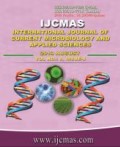


 National Academy of Agricultural Sciences (NAAS)
National Academy of Agricultural Sciences (NAAS)

|
PRINT ISSN : 2319-7692
Online ISSN : 2319-7706 Issues : 12 per year Publisher : Excellent Publishers Email : editorijcmas@gmail.com / submit@ijcmas.com Editor-in-chief: Dr.M.Prakash Index Copernicus ICV 2018: 95.39 NAAS RATING 2020: 5.38 |
Karanja estuary, an important estuarine ecosystem located adjoining to the Jawaharlal Nehru Port (largest container handling Seaport in India), Raigad district of Maharashtra. The North West coast of India is famous for the dol nets fishery. Dol nets (a kind of bag net) are operated in coastal seas having strong tidal currents and amplitude with its mouth opening always facing towards the direction of the tide. The present study was undertaken from September 2016 to May 2017 in Karanja estuary to record the Indian Ocean humpback dolphin pods and their interaction with dol nets and to understand the effect of anthropogenic activities on their population. The dolphins were identified to be as Indian Ocean humpback dolphin, Sousa plumbea (Osbeck, 1765) by using surface photo identification (photo-ID) techniques that rely on the natural marks on their dorsal fins, flukes and spot patterns. The food availability was found to be a significant reason for the interaction of dolphin with dol nets. The survey was conducted among the fisher folks to analyse the various threats associated with the dolphin pod survival. The stranding details of the dolphins around the study regions, recorded in past years, showed that this species is facing the pressure for its existence. The IUCN lists this species as endangered (EN) in the Red List of threatened species hence the immediate action is needed to protect this species before it becomes extinct from the estuarine habitat.
 |
 |
 |
 |
 |